Author: Daren MatsuokaRobert HackettEddy Lazzarin, a16z Crypto; Translator: 0xjs@黄金财经
Two years ago, when we published our first annual State of Cryptocurrency report, the world looked very different than it does now. Cryptocurrency was not high on the agenda of policymakers. Bitcoin and Ethereum exchange-traded products (ETPs) had not yet been approved by the U.S. Securities and Exchange Commission (SEC). Ethereum had not yet moved to energy-minimized POS. L2 networks designed to increase capacity and reduce transaction costs were largely inactive - transactions on these networks cost much more than they do today.
As our latest State of Cryptocurrency 2024 report shows, times have changed. Our report covers the rise of cryptocurrency as a hot policy topic, many of the latest technical improvements to blockchain networks, and the latest trends among cryptocurrency builders and users.
The report also:
delves into the emergence of key applications like stablecoins — one of crypto’s “killer apps”;
explores the intersection of crypto with other key tech trends like AI, social networking, and gaming;
shares new data on the level of interest in crypto in swing states ahead of the U.S. election, and more.
The 2024 State of Crypto report also reveals an all-time high in cryptocurrency activity. The report also analyzes how blockchain infrastructure is maturing — especially after recent scaling upgrades that have significantly reduced on-chain transaction costs, and the rise of Ethereum L2 and other high-throughput blockchains.
In 2024, we’re also launching a new tool: the a16z crypto Builder Energy dashboard. For the first time ever, we’re sharing proprietary data based on our unique insights into the crypto space, including where “builder energy” is located. The dashboard contains thousands of data points (aggregated and anonymized) from investment team research, our CSX Startup Accelerator Program, and other industry-wide tracking. With this tool, anyone can explore what crypto builders are saying about their activity and interest — from which blockchains they’re building on, to what types of applications they’re building, and what technologies they’re building with, and where they’re located. We plan to update this data annually as part of our annual State of Crypto.
Now take a look at the findings from our 2024 State of Crypto report.
7 key points
Cryptocurrency activity and usage hit record highs
Cryptocurrency has become a key political issue ahead of the US election
Stablecoins have found product-market fit
Infrastructure improvements have increased capacity and significantly reduced transaction costs
DeFi remains popular and growing
Crypto can solve some of the most pressing challenges facing AI
More scalable infrastructure unlocks new on-chain applications
1. Cryptocurrency activity and usage hit record highs
The number of monthly active crypto addresses has never been so high. In September, 220 million addresses interacted with the blockchain at least once, a number that has more than tripled since the end of 2023. (As a metric, active addresses are more easily manipulated than other metrics.)
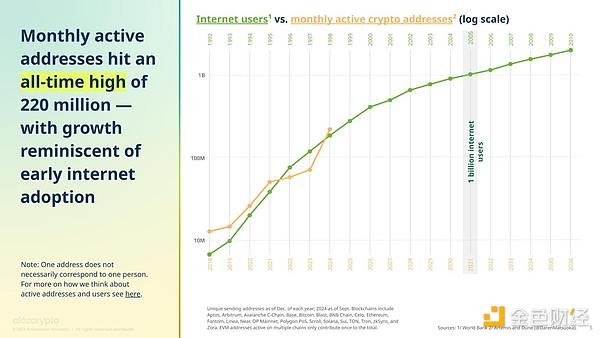 The surge in active addresses is largely due to Solana, which has about 100 million active addresses. It is followed by NEAR (31 million active addresses), Coinbase's popular L2 network Base (22 million), Tron (14 million), and Bitcoin (11 million). Among Ethereum Virtual Machine (EVM) chains, the second most active chain after Base is Binance's BNB chain (10 million), followed by Ethereum (6 million). (Note: The EVM chain calculates the total number of 220 million by deduplicating public keys.)
The surge in active addresses is largely due to Solana, which has about 100 million active addresses. It is followed by NEAR (31 million active addresses), Coinbase's popular L2 network Base (22 million), Tron (14 million), and Bitcoin (11 million). Among Ethereum Virtual Machine (EVM) chains, the second most active chain after Base is Binance's BNB chain (10 million), followed by Ethereum (6 million). (Note: The EVM chain calculates the total number of 220 million by deduplicating public keys.)

These trends are also reflected in our Builder Energy dashboard. The blockchain with the largest change in total share of builder interest is Solana. Specifically, the total share of founders who told us they are building or interested in building on Solana increased from 5.1% last year to 11.2% this year. Base had the second largest increase, with its total share increasing from 7.8% last year to 10.7%, followed by Bitcoin, whose total share increased from 2.6% last year to 4.2%.
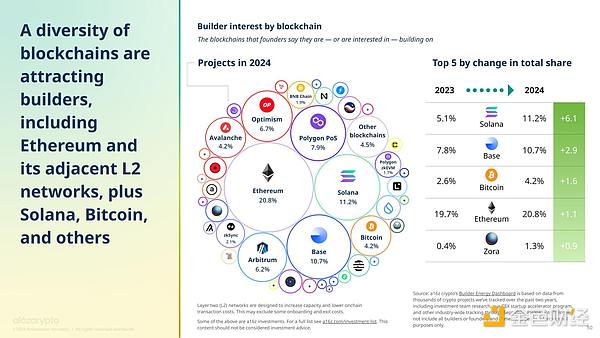
In absolute terms, Ethereum is still the most interesting project for developers, accounting for 20.8%, followed by Solana and Base, followed by Polygon (7.9%), Optimism (6.7%), Arbitrum (6.2%), Avalanche (4.2%), Bitcoin (4.2%), etc.
At the same time, in June 2024, the number of monthly mobile crypto wallet users hit an all-time high of 29 million. While the U.S. accounts for the largest share of monthly mobile wallet users at 12%, its share of the overall mobile wallet user base has declined in recent years as cryptocurrency adoption has grown globally and more projects have sought regulatory compliance by excluding the U.S. through geo-fencing.
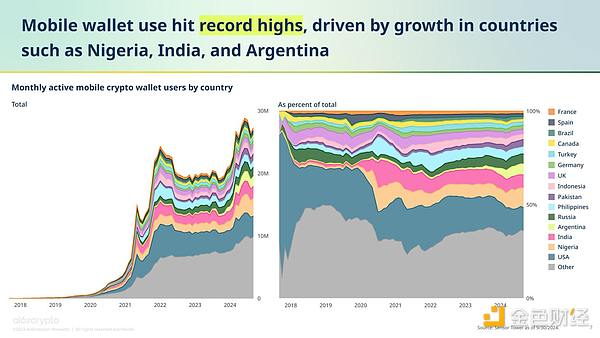
The footprint of cryptocurrency continues to expand overseas. After the U.S., the countries with the largest share of mobile wallet users include Nigeria (which has been trying to provide regulatory clarity through methods such as the Regulatory Incubation Program and has seen significant growth in consumer uses such as bill payments and retail purchases), India (which has a growing population and mobile phone penetration), and Argentina (which has seen many residents flock to cryptocurrencies, especially stablecoins, amid currency devaluation).
While it is easy to measure the number of active addresses and monthly mobile wallet users, measuring the number of actual active crypto users is much more difficult. However, by combining multiple methods, we estimate that there are 30-60 million monthly active crypto users worldwide, which is only 5-10% of the total 617 million global cryptocurrency holders estimated by Crypto.com in June 2024.
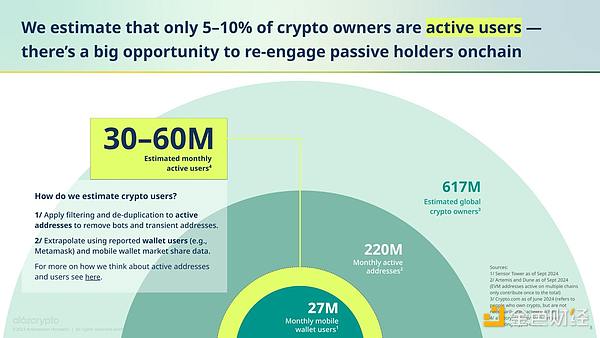
This discrepancy highlights the huge opportunity to attract and re-engage passive cryptocurrency holders. As major infrastructure improvements enable new and compelling applications and consumer experiences, more dormant cryptocurrency holders may become active on-chain users.
2. Cryptocurrency has become a key political issue ahead of the US election
Cryptocurrency has become a focus of discussion across the United States during this election cycle.
As a result, we measured the relative level of interest in cryptocurrencies in swing states. Pennsylvania and Wisconsin, two states expected to be the most intense battlegrounds in the November election, ranked fourth and fifth, respectively, in terms of the increase in cryptocurrency search interest since the last election in 2020, as a percentage of total search volume measured using Google Trends. Michigan ranked eighth in terms of the increase in cryptocurrency search interest, while Georgia remained unchanged. Meanwhile, Arizona and Nevada have seen a slight decline in interest in cryptocurrencies since 2020.
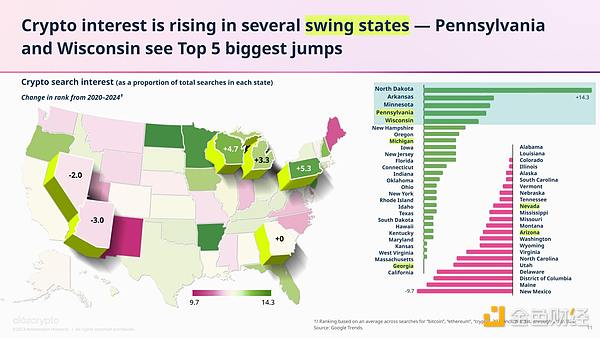
The listing of Bitcoin and Ethereum exchange-traded products (ETPs) this year could increase interest in cryptocurrencies. As such ETPs expand investor access, the number of Americans holding cryptocurrencies could increase. Combined on-chain holdings of Bitcoin and Ethereum ETPs already reach $65 billion. (Note: While these products are often referred to as ETFs, they are actually registered as ETPs using SEC Form S-1, which indicates that their underlying portfolios do not contain securities.)

SEC approval of ETPs is an important milestone for crypto policy. Regardless of which party wins the election in November, many politicians expect momentum to grow with the passage of bipartisan crypto legislation. More and more policymakers and politicians are taking a positive stance toward crypto.
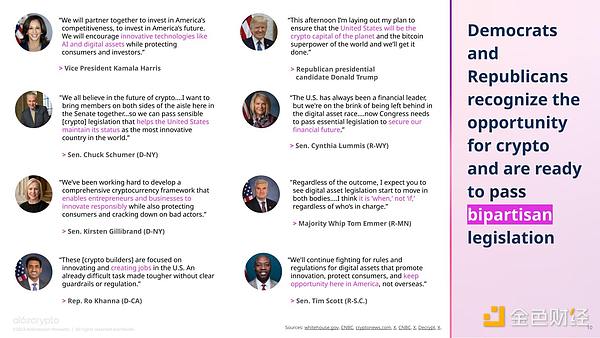
This year, the industry has also inspired other significant moves on the policy front. At the federal level, the House of Representatives approved the Financial Innovation and Technology for the 21st Century Act (FIT21) with bipartisan support, with 208 Republicans and 71 Democrats voting in favor. The bill, which is awaiting consideration and approval in the Senate, could provide much-needed regulatory clarity for cryptocurrency entrepreneurs.
Also meaningfully, at the state level, Wyoming passed the Decentralized Unincorporated Nonprofit Association (DUNA) Act, a law that gives legal recognition to decentralized autonomous organizations (DAOs) and allows blockchain networks to operate legally without compromising decentralization.
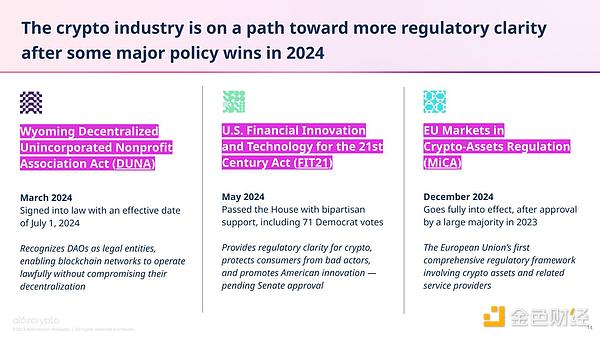
The European Union and the United Kingdom have been the most active in engaging with the public on cryptocurrency policy and regulation. European agencies have issued far more calls for opinions than, say, the U.S. Securities and Exchange Commission. Meanwhile, the EU's Markets in Cryptocurrencies Act (MiCA), the first comprehensive cryptocurrency-related policy regime to be passed into law, is expected to fully take effect by the end of this year. Stablecoins have become one of the most popular crypto products and one of the biggest topics of policy discussion, with multiple bills introduced in Congress. One of the positives, at least in the U.S., is the realization that stablecoins could bolster the dollar’s position overseas even as its global reserve currency status slips. Today, more than 99% of stablecoins are denominated in dollars, far more than the second-largest denomination: the euro, which accounts for 0.20%. In addition to demonstrating the dollar’s strength to the world, stablecoins could strengthen the country’s financial foundations. Despite being only a decade old, stablecoins have leapt into the top 20 holders of U.S. debt, putting them ahead of countries like Germany.
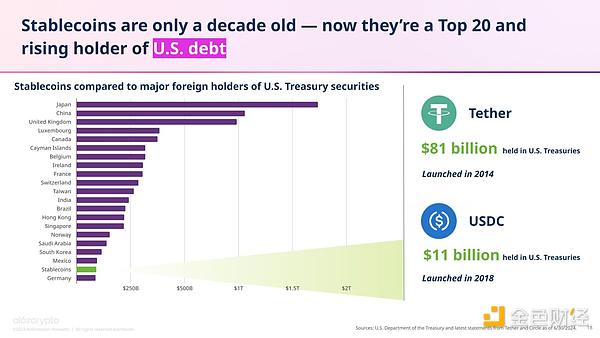
While some countries are exploring central bank digital currencies (CBDCs), the stablecoin opportunity before the United States is ripe. Judging from these discussions and the general views of many prominent politicians on cryptocurrencies now, we expect more countries to begin to seriously develop their cryptocurrency policies and strategies.
3. Stablecoins have found product-market fit
By enabling uses such as fast and cheap global payments, stablecoins have become one of the most obvious "killer apps" for cryptocurrencies. Indeed, as Rep. Ritchie Torres (D-N.Y.) wrote in a New York Daily News op-ed in September, “The proliferation of dollar-denominated stablecoins — fueled by the ubiquity of smartphones and the cryptography of blockchain — could become humanity’s greatest experiment in financial empowerment ever.”
Massive scaling upgrades have drastically reduced the cost of executing crypto transactions, including those involving stablecoins, by more than 99% in some cases. On Ethereum, transactions involving the popular dollar-pegged stablecoin USDC cost an average of $1 this month, down from an average of $12 in 2021. The average cost of sending USDC on Coinbase’s popular L2 network Base is less than a penny. (Note that these figures may not include some onboarding and exit costs.)
Compare these fees to the average $44 international wire transfer fee.
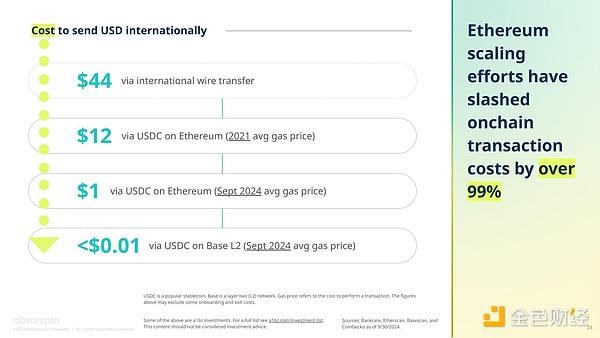
Stablecoins make value transfer simple. As of June 30, in the second quarter of 2024, stablecoins accounted for 1.1 billion transactions with a transaction volume of $8.5 trillion. During the same period, stablecoin transactions were more than double Visa's $3.9 trillion. Stablecoins are being discussed as much as well-known and entrenched payment services such as Visa, PayPal, ACH and Fedwire, fully proving their usefulness. Stablecoins aren’t just a passing fad, either. If you compare stablecoin activity to the volatile market cycles of cryptocurrencies, the two don’t seem to be correlated. In fact, even as spot cryptocurrency trading volumes have fallen, the number of addresses sending stablecoins each month has continued to rise. In other words, people appear to be using stablecoins for more than just transactions.
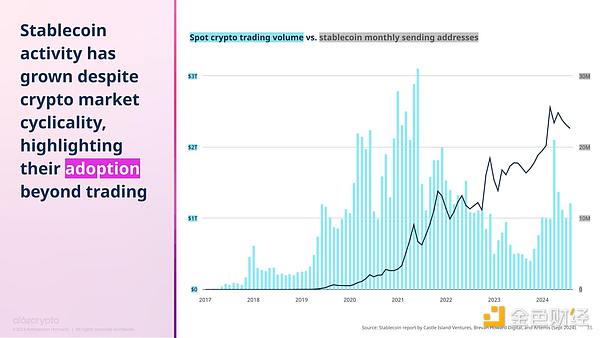
All of this activity is reflected in usage statistics. Stablecoins account for nearly a third of daily cryptocurrency usage, at 32%, measured by daily active address share, second only to decentralized finance (DeFi), at 34%. The rest of cryptocurrency usage is spread across infrastructure (bridges, oracles, maximum extractable value, account abstraction, etc.), token transfers, and a handful of other areas, including emerging applications such as gaming, NFTs, and social networks.
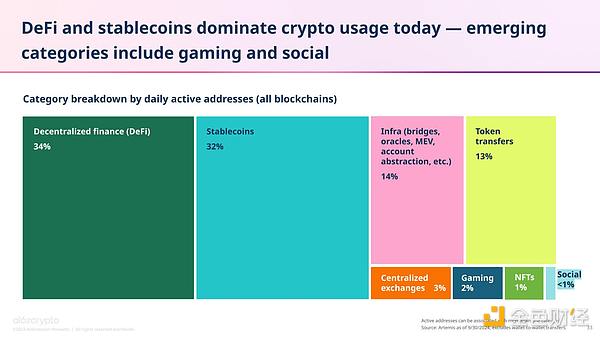
4. Infrastructure improvements have increased capacity and significantly reduced transaction costs
One of the reasons why stablecoins are so popular and easy to use is the progress of the underlying infrastructure. First, blockchain capacity is growing. Due to the rise of the Ethereum L2 network and other high-throughput blockchains, the number of transactions processed per second by blockchains is more than 50 times that of four years ago. Even more astonishing is that Ethereum’s biggest upgrade this year — “Dencun,” also known as “protodanksharding,” or EIP-4844 — drastically reduced fees on the L2 network after its implementation in March 2024. Since then, fees paid on L2 on Ethereum have fallen dramatically, even as the value of L2 denominated in ETH has continued to rise. In other words, the blockchain network is becoming more popular and more efficient.
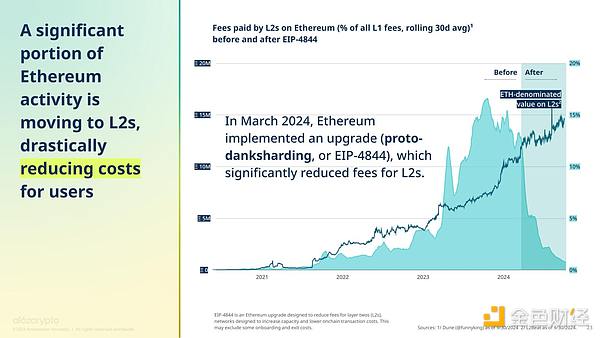
A similar situation is happening with zero-knowledge (ZK) proofs, another technology that holds important implications for blockchain scaling, privacy, and interoperability. While the amount of money spent on verifying Ethereum ZK proofs has fallen each month, the value denominated in ETH on ZK Rollups has increased. In other words, ZK proofs are also getting cheaper, even as they grow in popularity. (We use zero-knowledge here as an umbrella term for cryptographic techniques that can succinctly prove that computations offloaded to a Rollup network were performed correctly.)
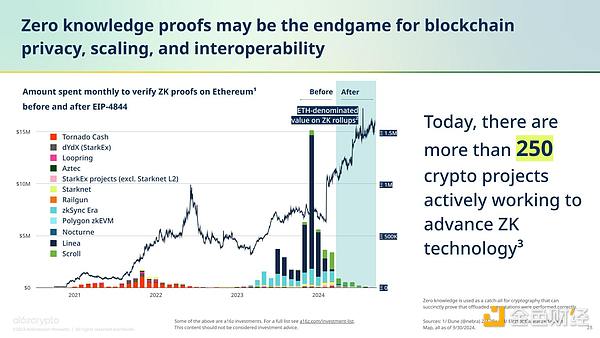
ZK technology is promising because it opens up new avenues for developers to perform cheap, verifiable blockchain computations. However, ZK-based virtual machines (zkVMs) still have a long way to go to catch up with the performance of traditional computers - a phenomenon worth noting. With all of these infrastructure improvements, it’s easy to see why blockchain infrastructure remains one of the most popular categories for builders, and why L2 has become one of the top five hottest builder subcategories we track.
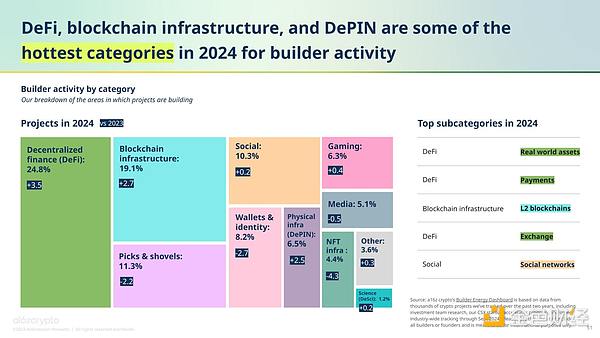
5. DeFi remains popular and growing
The only category that attracts developers more than blockchain infrastructure is decentralized finance (DeFi), which is also the category with the largest cryptocurrency usage, accounting for 34% of daily active addresses. Since the emergence of DeFi in the summer of 2020, decentralized exchanges (DEX) have grown to 10% of spot cryptocurrency trading activity-all of which happened on centralized exchanges four years ago.

Currently, there is more than $169 billion locked in thousands of DeFi protocols. Some of the top DeFi subcategories involve staking and lending.

It’s been just over two years since Ethereum completed its transition to proof-of-stake, significantly reducing the network’s energy consumption and environmental footprint. Since then, the share of staked ether has risen to 29% from 11% two years ago, greatly enhancing the security of the network. Although DeFi is still in its early stages, it offers a promising alternative to the centralization and power consolidation trends in the U.S. financial system, which has seen the number of banks fall by two-thirds since 1990, and the big banks’ share of assets is getting smaller and smaller.
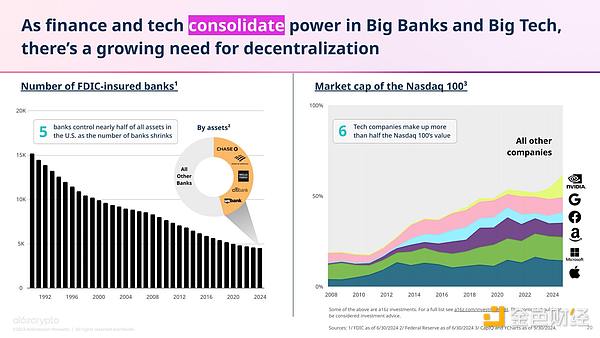
6. Cryptography can solve some of the most pressing challenges facing AI
AI is one of the hottest trends this year, not only in the technology field, but also in the crypto field.
AI is one of the most discussed trends among cryptocurrency influencers on social media. Perhaps more surprisingly, there is a large overlap between visitors to chatgpt.com and visitors to top cryptocurrency websites, indicating a close connection between cryptocurrency and artificial intelligence users.
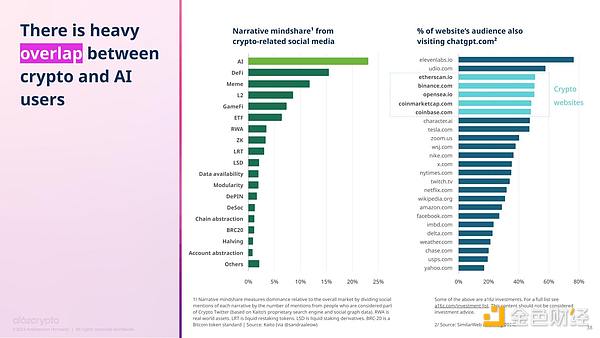
Crypto builders also have a strong connection with AI. According to our Builder Energy dashboard, about a third of cryptocurrency projects (34%) said they are using AI, regardless of the category they are building, up from 27% a year ago. The most popular category for applying artificial intelligence technology is blockchain infrastructure projects.
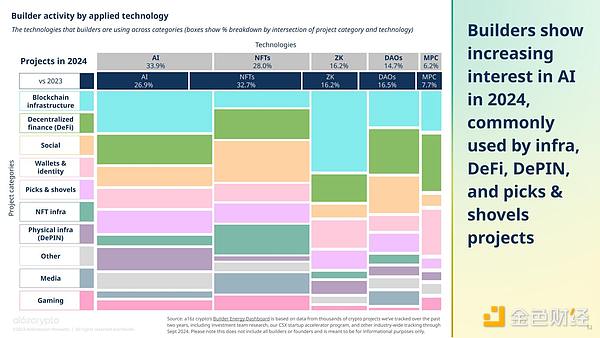
Given that the cost of training cutting-edge AI models has increased 4 times per year over the past 10 years, we believe that AI may tend towards the centralization of Internet power. If left unchecked, only the largest technology companies will have the resources to train the latest AI models. The challenges associated with centralization of AI are almost the exact opposite of the decentralized opportunities offered by blockchain networks. Crypto projects are already attempting to address some of these challenges today, including Gensyn (by democratizing access to AI computing), Story (by tracking IP to help compensate creators), Near (by running AI on an open-source, user-owned protocol), and Starling Labs (by helping verify the authenticity and provenance of digital media), to name a few.
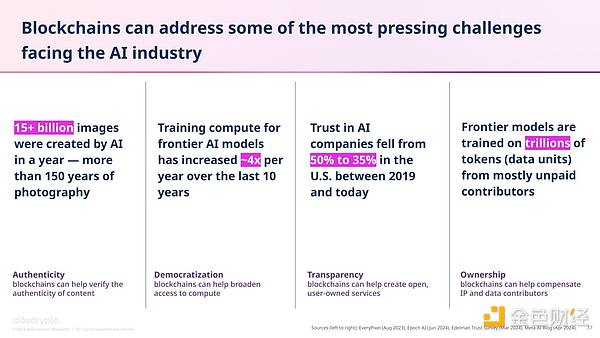
The crossover between Crypto x AI is likely to intensify in the coming years.
7. More scalable infrastructure unlocks new on-chain applications
Many other potential crypto consumer applications become possible as transaction costs fall and blockchain capacity rises.
Take NFTs as an example. A few years ago, when cryptocurrencies were trading much higher, people traded NFTs in the secondary market for billions of dollars. Since then, this activity has subsided, replaced by a new consumer behavior: minting low-cost NFT collectibles on social applications such as Zora and Rodeo. This represents a significant shift in the NFT market, one that was largely unthinkable before transaction fees were drastically reduced. Another example is social networks. While they currently represent only a small portion of daily on-chain activity, they attract strong builder activity: according to our Builder Energy dashboard, 10.3% of crypto projects will be social-related by 2024. In fact, social network-related projects, such as those associated with Farcaster, are among the top 5 builder subcategories this year.
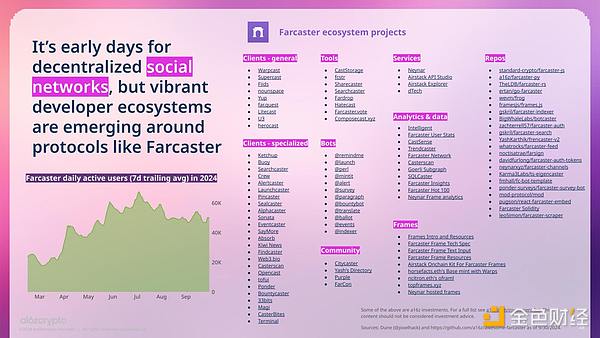
While developers and consumers explore more social experiences, on-chain games are pushing blockchain expansion to its limits. The Rollup used by Proof Of Play's high seas adventure role-playing game "Pirate Kingdom" has always consumed the most gas per second among all Ethereum Rollups.
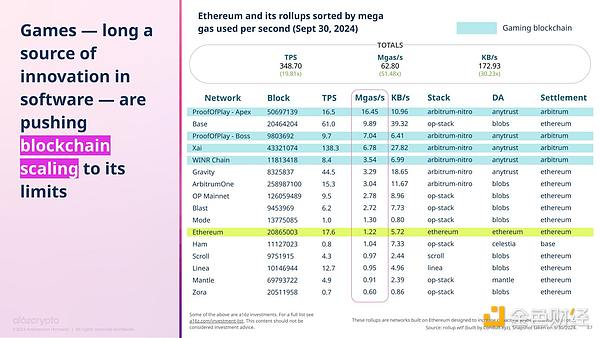
With the November election approaching, cryptocurrency-based prediction markets are gaining momentum — even though they are illegal in the United States — and prediction markets in general are gaining momentum. So much so that Kalshi, a non-cryptocurrency-based prediction market registered with the U.S. Commodity Futures Trading Commission, won a federal lawsuit in a lower court last month over listing election contracts. (As of now, registered exchanges are allowed to offer traditional election-based futures contracts.)
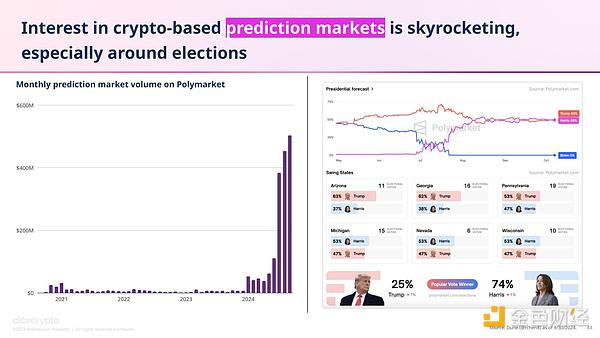 New signs of consumer behavior are beginning to emerge. All of these emerging experiences were difficult to achieve when blockchain infrastructure was cumbersome and transaction costs were high. As blockchain continues to improve along the price-performance curve of traditional technologies, more of these applications are expected to flourish.
New signs of consumer behavior are beginning to emerge. All of these emerging experiences were difficult to achieve when blockchain infrastructure was cumbersome and transaction costs were high. As blockchain continues to improve along the price-performance curve of traditional technologies, more of these applications are expected to flourish.
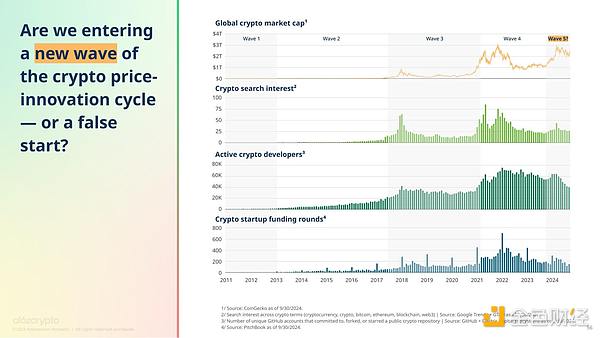
Where does this leave us? Cryptocurrency has made significant progress in policy, technology, consumer adoption, and more over the past year. These include policy milestones, including the sudden approval and listing of Bitcoin and Ethereum ETPs, and the passage of significant bipartisan cryptocurrency legislation. There have been major infrastructure improvements, from scaling upgrades to the rise of Ethereum L2 and other high-throughput blockchains. There are also new applications being built and used, from the growth of pillars such as stablecoins to the exploration of emerging categories such as AI, social networks, and gaming.
Whether we have entered the fifth wave of the price innovation cycle (our framework for understanding the ups and downs of many market cycles in cryptocurrencies) remains to be seen. Regardless, cryptocurrencies as an industry have made indisputable progress over the past year. As ChatGPT proves, it only takes one breakthrough product to transform an entire industry.
 Brian
Brian
 Brian
Brian Weiliang
Weiliang Joy
Joy Miyuki
Miyuki Joy
Joy Alex
Alex Joy
Joy Brian
Brian Weiliang
Weiliang Miyuki
Miyuki